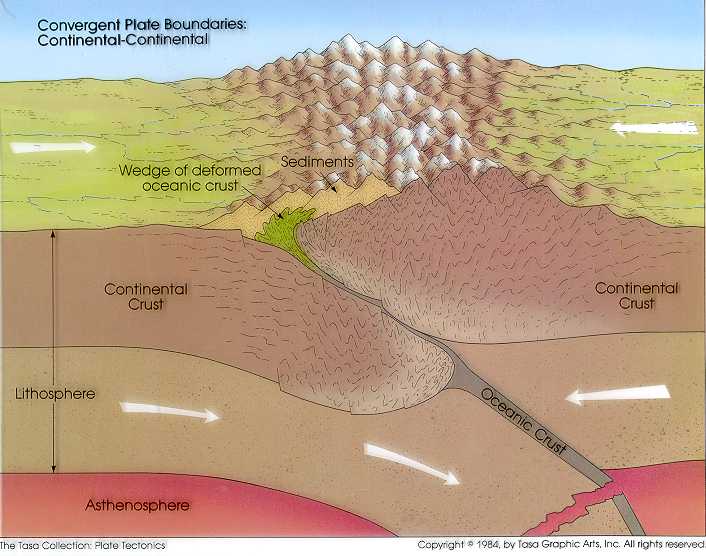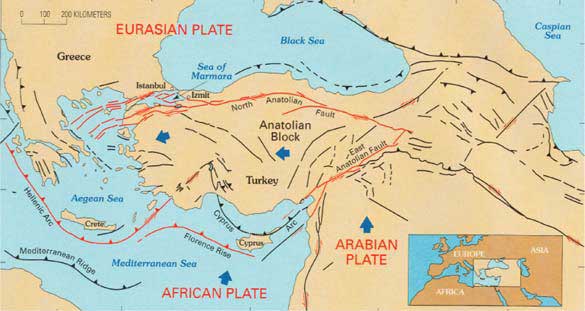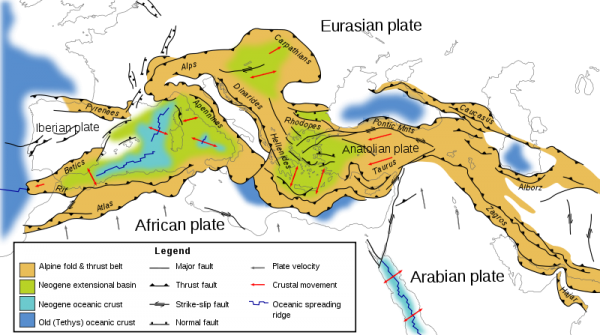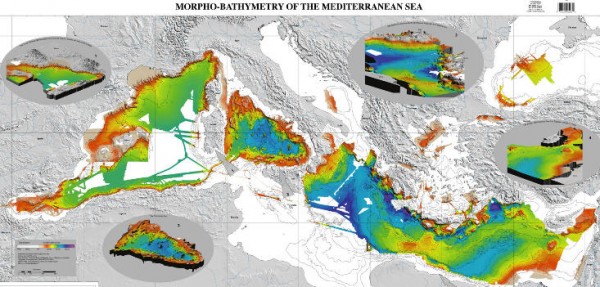Europe is about to move below Africa

We may be seeing the start of a new subduction zone. The Eurasian plate is 85% land mass with a very undefined plate boundary on its southern border connecting to the African, Indian and Australian plates. The continents are converging; and for many millions of years, the northern edge of the African tectonic plate has descended under Europe.
Geologic features in the present-day Mediterranean essentially result from two major processes: the tectonic displacement caused by the subduction of the African plate underneath the Eurasian plate; and the progressive closure of the Mediterranean sea involving a series of submarine-insular sills.
The development of the Mediterranean basin begins with the breakup of the supercontinent Pangea in the Mesozoic. During this time, sea-floor spreading triggered the development of the Atlantic ocean in the Triassic period, which separated the African and Eurasian plates from the North American plate. Sea-floor spreading in another geographical location caused the development of the Tethys ocean, separating the African plate from the Eurasian. In the late Cretaceous period, these African and Eurasion plates began to converge, closing the Tethys ocean basin, and the remnants of this ancient ocean are now called the Mediterranean sea.
The Ionian sea perhaps experiences the major amounts of subsidence in the Central Mediterranean. The Ionian Abyssal Plain in this region is characterized by differentially sudbsiding areas but generally experiences more than adjacent regions, contributing greatly to the uplift associated with the Alpine orogeny and the Quaternary coastal blocks. The Hellenic trench (a thrust fault linked to the convergent activity in the Mediterranean ridge) began propagation in Miocene and continues today; it constitutes a major element of Ionian seafloor topography. The extensional features in the Ionian region are somewhat subdued, the dominant tectonic activity is convergent and/or related to vertical movement. (Geological history of the Central Mediterranean – Outline of Cenozoic Events)
The cold, dense rock beneath the Mediterranean Sea, at the far north of the African plate has sunk under the Eurasian plate on which Europe sits. But the African landmass is too light to follow suit and descend. The slow convergence – just a few centimetres per year – was obstructed partially by collision of the two plates further East, in Turkey, and then by the fact that the lightness of the African continent prevented further subduction. As a result, bits of the African plate that did subduct have broken off and are descending to the Earth’s mantle. There is old volcanic activity south near Africa with sparsely scattered earthquake activity within a few hundred miles.

On the other side, bits of the Eurasian plate have been pulled southwards across the Mediterranean, such as the Balearic Islands, Corsica and Sardinia. The same thing is happening with Crete. And computer modelling suggests the end product of all this could be the initiation of subduction in the opposite direction from the past. Additional evidence comes from observations of earthquakes.
Tsunamigenic earthquakes in the Mediterranean are smaller than the biggest ones around the Pacific rim. Magnitude 8 events have been recorded, such as the 1303 Crete quake whose tsunami devastated Heraklion and Alexandria. The 1303 Crete earthquake occurred at about dawn on 8 August. It had an estimated magnitude of about 8 and triggered a major tsunami that caused severe damage and loss of life on Crete and at Alexandria. The location of the epicenter is uncertain although it is generally agreed that it ruptured the eastern segment of the Hellenic arc somewhere between Crete and Rhodes. The earthquake caused damage over a wide area including Crete, Peloponnese, Rhodes, Cairo, Acre, Damascus, Antioch and Cyprus and was felt as far away as Constantinople (1,000 km (621 mi)) and possibly Tunis (1,500 km (932 mi)). The magnitude is uncertain but is considered to be about 8.0. In a tectonically active region, the Earth’s crust is subject to strong forces causing it to deform. In the case of Greece, the region is being pulled apart (it is extending), and we can see this extension in the topography of the landscape. Most of it’s faults are in a North-West to South-East direction, which is perpendicular to the direction of extension. (Greece is extending in a North-East to South-West direction.) This geometry of faulting allows the largest amount of extension on the smallest number of faults.
(Mediterranean Tsunami Evidence Found in Subsurface Sediments)
The Utrecht group’s analysis of the Mediterranean Sea’s complex geological structure and history reveals that the continents’ slow convergence of a few centimetres each year was partially obstructed by the collision of two plates further east, in Turkey. And further subduction was prevented by the lightness of the African continent. Parts of the African plate that did subduct broke away and are now descending towards the Earth’s mantle. If there is confirmation that subduction has begun, scientists would be be able to make better assessments of the earthquake and tsunami risk in Europe. However, despite the smaller risk of natural events in the region, there is concern that European countries are not investing enough money into building a tsunami warning system.
(The Geological Evolution of East Mediterranean)
The main seismically active areas of Europe are associated with the active margin between Southern Europe and Africa. Africa is pushing northwards into Europe creating a collision zone. The Mediterranean is split into a number of microplates which form subduction zones,continental plate collision zones and conservative fault zones.As Africa has pushed northwards against Europe the floor of the Mediterranean has sunk into the mantle along a crack in the earths crust along subduction zones causing new magma to rise to the surface. Main areas of volcanism are in southern Italy and Greece. Earthquake activity occur from Turkey to Spain.
The volcanoes of the Mediterranean are explosive and potentially more dangerous to people. Vesuvius ( AD79) and Santorini both erupted suddenly and violently devastating their surrounding populations. These volcanoes are the classic cone and crater volcanoes with lots of ash.
Mt. Etna shows both types of volcanism and is one of Europes most dramatic and active volcanoes. It dominates the Eastern side of Sicilly with its snow capped summit.
Europe’s future lies under Africa, scientists suggest (BBC)
Role reversal: Is Europe about to move below Africa as direction of tectonic plates shifts? (DailyMail)





One of the Azores Islands is already descending. Please check the possibility of a disturbance there resulting in a tsunami that might affect the Atlantic coasts of Europe and North America.